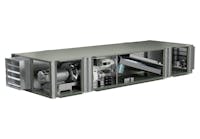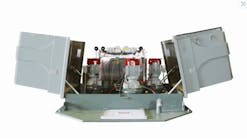Processes are the life blood of industrial operations. Yet, like virtually every aspect of life and work in 2020, the global pandemic ushered in a wave of changes, ranging from social distancing efforts to protect workers to disruptions in process cycles.
Below, Doug Fast, Senior Engineering Lead at Owens Corning, shares his perspective on how the pandemic and other extreme events in 2020 have impacted the pipes and systems that make up processes in industrial facilities.
What macro-level factors affected industrial processes in 2020?
Many factors including shifts in marketplace demand and social distancing placed additional stress on industrial facilities. These challenges were particularly pronounced in the petrochemical and oil and gas sectors. Even prior to the pandemic, an over-supply of crude oil was causing a shift toward intermittent processing cycles. This market situation led to equipment in refineries being repeatedly shut down and powered up.
The oil market’s supply versus demand constraints in the first quarter prompted many industrial suppliers to pivot toward producing more profitable materials. For example, petrochemical facilities adapted their operations to produce chemicals needed in the manufacturing of plastics used to package consumer goods like disinfectants and household cleaners. This led to abrupt changes in process cycling and put added stress on process equipment.
Another significant trend intensified by the pandemic was a greater focus on the safety culture in organizations. A much higher emphasis was placed on efforts to increase space between workers via social distancing to prevent the spread of COVID-19. On the job site, products that place more distance between workers due to their size and design and that can be installed by one person can aid in social distancing. For example, a 4-foot pipe insulation length inherently allows for more space between installers than shorter length pipe insulation.
What problems do shorter duty cycles impose on equipment?
Fluctuations in temperature – particularly the big variances that occur when equipment is shut down – contribute to CUI. When processes are brought up to operating temperature, the heat keeps moisture from accumulating on pipes. However, as the equipment cools down following a shut-down, the cooler surface temperatures can allow both liquid and vapor moisture to condense between the insulation and pipes – opening up the opportunity for corrosion. Then, as the equipment is powered back up, it has to boil the moisture off yet again. As the water evaporates from the metal surface, corrosive materials such as chlorides remain. Continuous exposure to moisture leads to the accumulation of contaminants and more corrosion formation.
What causes CUI and how can it be mitigated?
Corrosion under insulation (CUI) is one of the biggest concerns in industrial operations, but particularly for high temperature applications. CUI refers to any type of corrosion that occurs due to moisture on the external surface of an insulated pipe system. The potential consequences CUI presents include reduced lifetime of the asset, increased risk of leaks, shutdowns and potential injury risks for personnel working in production facilities
The most prevalent cause of CUI is moisture that works its way into the insulation system. Improper installation or damaged jacketing can allow moisture to condense between the insulation and the exterior surface of the pipe.
What are some best practices to deploy when returning idled equipment to operation?
Consulting equipment maintenance logs will confirm the condition and performance status of equipment prior to a shut-down. Excessive energy consumption or loss suggests a problem demanding further inspection. Manufacturers provide specific guidelines for equipment, but there are some general best practices when it comes to powering systems back up. Systems in facilities that produce high risk products such as volatile and reactive gases require more rigorous and frequent inspections. On piping, signs of a potential problem include leaks and compromised jacketing material. Look for visible signs of steam, smoke or leaking of either moisture or process products such as refrigerants. Beyond CUI, product in pipes could be leaking or wicking into insulation, posing a potential fire risk.
This year brought extreme weather to many regions. What risks does weather pose for CUI?
Humidity and wind-driven rain can infiltrate any crack or opening in the insulation system. The inclusion of insulation into mechanical and industrial processes is still relatively recent compared to the age of industrial infrastructure. Whenever possible, water must be kept out of the insulation system. One solution is to provide a way for moisture to exit if it gets past the jacketing through the use of drain holes and inspection plugs. And finally, a rigorous and regular inspection and maintenance plan is very important to monitor processes and the effectiveness of the insulation system.
It’s worth pointing out that as the pandemic has generated increased interest in systems that support increased ventilation and air flow, moisture can also be introduced into the insulation system in vapor form, where it can contribute to CUI. And the historic rains that have hit parts of the Gulf Coast point to the threat flooding presents. When flooding occurs, there is no choice but to tear everything out – particularly when you’re dealing with salt water.
How does fire risk factor into industrial specifications?
A historic fire season is a reminder that moisture is not the only threat that must be managed in industrial spaces. Material specifiers must also keep in mind a material’s fire resistance to protect life safety and structural integrity in the event of a fire. Mineral wool used to insulate pipes supports both process advantages. Its non-combustible nature allows more time for occupant egress and supports structural integrity by insulating assets from extreme heat.
With a piping system, adequate insulation will increase the time it takes for contents flowing through the pipe to heat up when exposed to extreme heat from a fire. Compared to other insulating materials that start to melt or deteriorate around 1,300°F, mineral wool insulation is fire resistant to temperatures up to 2,000°F.
Beyond providing time for occupants to egress a facility, a material can also influence structural performance. For example, insulating a structural component supporting equipment such as a tank containing volatile contents will heat more slowly if it is properly insulated. Once temperatures reach 1,000°F, a steel structure will lose about half its strength. Insulation for vessels and equipment – such as tanks storing flammable or volatile substances – can help support structural integrity.
What changes in industrial facilities may arise from the events of 2020?
Many of these changes will likely stay in place long after we enter the new normal. Safety is likely to have an even higher level of scrutiny. Consider how the tragic events of 9/11 led to more stringent security in airports. Other changes may include less human traffic in facilities due to social distancing, and reduced occupancy or idled operations that prompt facilities to invest in infrastructure – such as automated systems, cameras or other equipment that might have been put off at busier times.
##########










